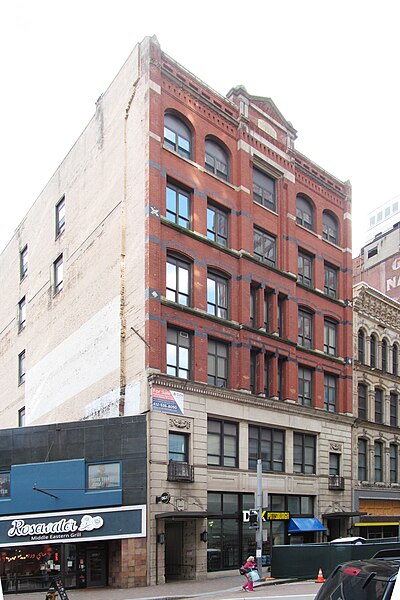
Comments

The history of the Horne’s building is a complicated one. The original building was one of the last works of William S. Fraser, one of the most prominent Pittsburgh architects of the second half of the nineteenth century. Only a few years after it opened, a huge fire burned out much of the interior. Some of the original remained, but, since Fraser had died, Horne’s brought in Peabody & Stearns, a Boston firm that also had an office in Pittsburgh, to design the 1897 reconstruction. Another fire hit the building in 1900, but most of it was saved. You can see a thorough report on the fire, with pictures, at The Brickbuilder for May, 1900.

In 1922, a large expansion was added to the building along the Stanwix Street side, with the style carefully matched to the 1897 original. The new building was taller by one floor, but all the details were the same, including the ornate terra-cotta cornice.




The Horne’s clock, a later addition, is not as famous as the Kaufmann’s clock, but it served the same purpose as a meeting place for shoppers. It is once again keeping the correct time.

The decorated cornice of the Horne’s building gleams in late-afternoon sun.


Not the one with the Christmas tree, but the one before that. Horne’s was Pittsburgh’s first department store, and in 1880 the already-well-established Joseph Horne Company built this grand mercantile palace. It was Horne’s for only about seventeen years: in 1897, the department store moved to its much larger location at Penn Avenue and Stanwix Street, where it would stay for almost a century. After that, the Pittsburgh Post moved into this building, and later the Sun as well, when they were under the same ownership.

The Wikipedia article on the Joseph Horne Company is a mess, and old Pa Pitt ought to work on rewriting it, except that it would require extensive research. Among other things, it tells us (without citing a source) that this building was built in 1881 (which may be when it opened) and was designed by Charles Tattersall Ingham, who would have been four years old when he designed it. Decent work for a four-year-old. However…

The lower floors got a complete makeover in 1920, when the building was a newspaper headquarters, and that part of the building is in the trademark Ingham & Boyd style: rigorously symmetrical, with meticulously correct classical detailing. Charles Tattersall Ingham would have been 44 years old then, right in the middle of a prosperous career. Old Pa Pitt will therefore tentatively attribute that 1920 remodeling to Ingham & Boyd.

Do you have plans for a luxury-apartment project downtown? Here is your opportunity. Everyone else is doing it.
